Eco-Friendly Ways to Keep Bees and Wasps Away

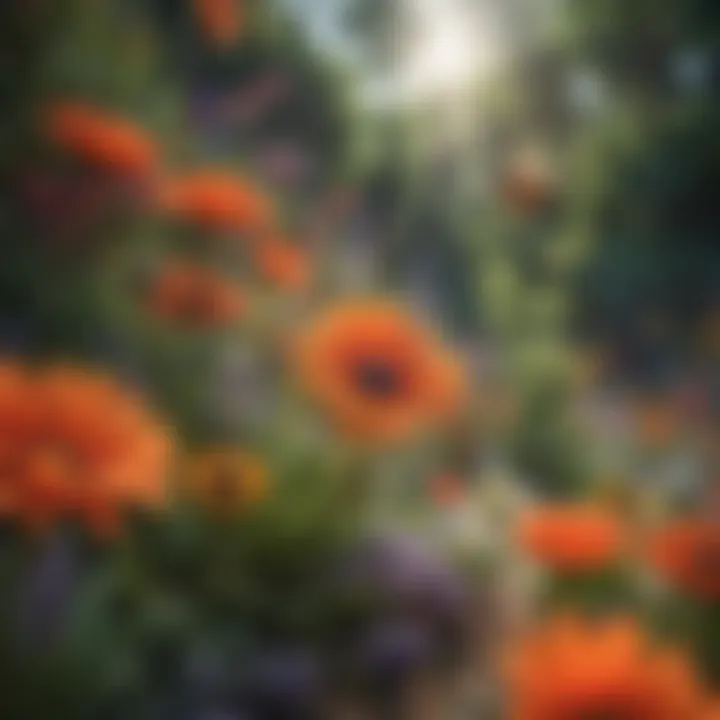
Understanding Pests
Pests are organisms that can cause harm to plants, humans, or animals. When we discuss bees and wasps, it is essential to identify their role in the ecosystem. While they may be considered pests, many of these insects actually contribute to pollination and biodiversity. However, their presence can also pose risks, especially when they nest in close proximity to homes.
Understanding the species is vital for effective management. For instance, honeybees are generally more docile and critical for pollination compared to wasps, which may be more aggressive in protecting their nests. Homeowners should learn to identify these insects to address their concerns appropriately.
Importance of Pest Identification
Identifying pests accurately aids in developing natural deterrence strategies. Misidentifying a bee as a wasp, for example, can lead to improper responses that might exacerbate the problem.
- Bees: Generally hairy, skilled at pollinating plants.
- Wasps: Smooth, slender bodies, tend to be more aggressive when provoked.
Recognizing their differences allows for more effective control measures.
Prevention Techniques
Preventive measures focus on reducing the likelihood of attracting bees and wasps to your surroundings. A combination of home and garden strategies can create a less favorable environment for these insects.
Home and Garden Preventative Measures
In the garden, certain practices can help deter these pests. Consider the following approaches:
- Avoid floral plants that are particularly attractive to bees and wasps, such as asters and sunflowers.
- Implement barrier methods, such as sealing potential nesting sites in eaves and other areas.
- Keep garbage bins tightly sealed to reduce food sources.
Seasonal Prevention Tips
Understanding that bees and wasps follow seasonal patterns can assist in timing preventive measures effectively.
- Spring: Monitor for early signs of nests. Remove old nesting materials if found.
- Summer: Ensure all food waste is disposed of properly. Increase vigilance, as wasp activity peaks during this time.
- Fall: Document nests. If feasible, plan for their removal when insects become less active.
Eco-Friendly Pest Control Solutions
Shifting focus to sustainable methods offers an alternative to chemical pesticides. Integrative pest management strategies make the best use of natural resources without harming the environment.
Overview of Sustainable Practices
Sustainable practices often emphasize a balance between nature and human needs. They encourage the use of beneficial insects to control pest populations, creating a healthier ecosystem overall.
- Plant native flora that attracts beneficial insects.
- Create habitats to encourage natural predators like birds.
Natural Remedies and Their Effectiveness
Various natural remedies can deter bees and wasps effectively. Common solutions include:
- Peppermint Oil: Known for its strong scent, peppermint oil acts as a potent repellent when diluted in water and sprayed in areas of concern.
- Vinegar Traps: Mixing sugar, vinegar, and water can attract and trap wasps effectively.
- Cucumber Slices: Surprisingly, slices of cucumber can deter wasps due to their chemical composition.
Effective prevention and control require knowledge of insect behavior and an understanding of the local environment.
By employing these natural strategies and approaches, homeowners can create an environment that is uninviting to bees and wasps while allowing beneficial insects to thrive.
Understanding Bees and Wasps
Understanding bees and wasps is crucial for several reasons. Both contribute significantly to biodiversity and play vital roles in ecosystems. Bees, in particular, are key pollinators for many of our crops and flowers. This means they indirectly affect food production and ecological balance. Conversely, wasps, while sometimes seen as pests, also serve a purpose by helping manage other insect populations. They can reduce pest numbers, which might otherwise damage plants and crops.
Knowledge of these insects allows homeowners and gardeners to appreciate their positive impacts before resorting to harmful deterrents. It also informs more effective management strategies when bees and wasps become problematic. Recognizing the distinction between beneficial insects and actual threats is a significant step toward developing natural strategies for pest control. This understanding can lead to sustainable practices that promote a healthy environment while minimizing conflict with these insects.
Types of Bees and Wasps
Bees and wasps belong to different families but share some characteristics. The two groups are diverse. Common types of bees include honeybees, bumblebees, and solitary bees. Each type has its behavior and habitat. Honeybees are social insects, living in colonies and producing honey. Bumblebees are also social but have shorter lifespans and are known for their fuzziness. There are many solitary bees, which do not form colonies but are essential for pollination.
Wasps also come in various forms, such as yellowjackets, hornets, and paper wasps. Yellowjackets are known for their aggressive nature and can be a nuisance at outdoor gatherings. Hornets, being larger, can also be territorial but tend to be less aggressive than yellowjackets. Paper wasps build distinctive nests and are generally less harmful. Recognizing these types allows for better strategies to manage their presence effectively.
The Role of Bees in Ecosystems
Bees play an irreplaceable role in our ecosystems. They facilitate the process of pollination, essential for the reproduction of many plants. This, in turn, supports other life forms by providing food sources like fruits and vegetables. Without bees, numerous plants would struggle to reproduce and decline in numbers, leading to a collapse in the food web.
The ecological balance is maintained through these interactions, showcasing how dependent we are on bees. Their decline can have cascading effects, making its preservation critical. Understanding this role can foster appreciation and motivate protective measures that benefit both bees and human interests.


When Bees and Wasps Become a Problem
Despite their benefits, bees and wasps can become problematic under certain conditions. For instance, during warmer months, their populations can surge, leading to increased interactions with humans. When food sources are scarce, they may invade outdoor spaces, seeking sugary foods or proteins.
Aggression can pose risks, especially for individuals with allergies. Honeybees rarely sting, while yellowjackets and hornets can be more aggressive. Recognizing when these insects cross from beneficial to problematic is essential for implementing effective management strategies. Awareness helps in choosing the right time and methods to deter them without compromising their benefits to the ecosystem.
Recognizing Attractants
Understanding what attracts bees and wasps to your outdoor space is crucial for effectively managing their presence. Recognizing attractants allows homeowners to adjust their environments and reduce the likelihood of an infestation. By becoming aware of specific food sources and environmental factors, you can implement strategies that minimize the appeal of your property to these insects. This not only helps in keeping your space enjoyable and safe but also promotes ecological balance by using methods that do not harm beneficial insects.
Common Food Sources for Bees and Wasps
Bees and wasps are particularly drawn to certain food sources found in gardens and outdoor areas. Some of the most common attractants include:
- Fruits: Ripe or overripe fruit, such as apples, pears, and berries, naturally attracts these insects due to their sugars.
- Sugary Foods: Anything that contains sugar, like soda, honey, or sweet desserts, can lure these insects to your picnic or outdoor gathering.
- Protein Sources: Wasps, especially, are interested in high-protein foods such as meats. Uncovered food at barbecues can easily become a target.
To help discourage bees and wasps, keep food covered and clean up spills promptly. This simple practice reduces the chances of attracting them into your area.
Environmental Factors that Draw Insects
Certain environmental characteristics can influence the behavior of bees and wasps as well. Factors include:
- Water Sources: Standing water can also attract bees and wasps. If you have bird baths or puddles, consider their placement. Space them away from high-traffic areas.
- Shelter Sites: Dense foliage or areas with clutter may provide nesting opportunities for these insects. Ensuring your yard is clean can prevent potential nests from forming.
- Flowering Plants: While bees are important pollinators, flowering plants can also attract wasps. If you want to manage their presence, choose less attractive plants or consider their placement in your landscape.
By understanding these factors, you can make appropriate changes to your yard to minimize attraction while still maintaining its beauty. Adjusting these elements in your garden can play a significant role in not encouraging an influx of bees and wasps.
"Effective management starts with understanding what draws bees and wasps in, making proactive adjustments can create a more comfortable outdoor space."
Natural Repellents
Natural repellents are crucial in managing bees and wasps effectively. They offer homeowners an ecological way to deter these insects without using harsh chemicals. Utilizing natural repellents not only preserves local ecosystems but also promotes safety for pets and children. They provide a sustainable solution by using readily available ingredients, helping to maintain an insect-friendly environment while keeping unwanted pests at bay.
Essential Oils as Deterrents
Essential oils serve as popular natural repellents due to their potent fragrances that bees and wasps find unpleasant. These oils are typically derived from plants, making them a safe alternative to chemical sprays. Their effectiveness can vary based on the concentration and application method.
Peppermint Oil
Peppermint oil is known for its strong scent that repels many insects. The refreshing aroma can deter not only bees but also wasps. This oil is beneficial because it is widely accessible and easy to use. A unique feature of peppermint oil is its ability to mask attractants that may draw in these insects. However, its effectiveness can diminish through excessive sunlight exposure or alterations in application methods.
Citronella Oil
Citronella oil is another well-regarded option, often used in candles and sprays. It is known mainly for its mosquito-repelling properties, but it can also deter wasps and bees. The key characteristic of citronella oil is its natural source from grass, which makes it a widely accepted choice among eco-conscious individuals. One advantage of this oil is its pleasant smell that many people enjoy. However, its scent can dissipate quickly, requiring frequent reapplication.
Eucalyptus Oil
Eucalyptus oil has a unique aromatic profile that effectively dissuades bees and wasps. The oil is frequently included in homemade repellents because of its dual function: it smells refreshing while repelling insects. Its benefits include a longer-lasting effect compared to some other oils. However, eucalyptus oil can have irritants for people with sensitive skin, so caution is advised when applying directly.
Herbs That Naturally Deter Bees and Wasps
Herbs are another wonderful resource for natural deterrents because of their fragrances and properties. These plants can be used in gardens or as potted plants around outdoor areas, providing a beautiful appearance while deterring pests.
Basil
Basil is a versatile herb known for its culinary uses. It also acts as a deterrent for bees and wasps. The aroma is strong and can mask the scents that attract insects. One main advantage of basil is its easy cultivation and ability to grow indoors or outdoors. The downside is that it requires proper care and may not thrive in all climates.
Mint
Mint is recognized for its refreshing scent, which is effective in keeping bees and wasps away. This herb is especially popular among home gardeners. Its rapid growth and spreading ability help in creating a barrier against these insects. One consideration is that mint can become invasive if not managed, competing with other plants.
Rosemary
Rosemary is not only used for flavoring dishes but is also known for its insect-repelling qualities. Its woody scent can ward off bees and wasps, making it a desirable plant in gardens. The longevity of rosemary as a robust plant allows for continuous availability of its repelling properties. However, it does require specific growing conditions to flourish.
Creating an Uninviting Environment
Creating an uninviting environment for bees and wasps is key in minimizing their presence without harming them or the environment. Insects like bees and wasps are naturally drawn to areas that provide food, shelter, and a comfortable habitat. Therefore, the focus should be to reduce these attractants through careful management.
By addressing how to manage outdoor waste and employing decoys or traps, homeowners can successfully dissuade these insects from making their space their own. This approach not only reduces the risk of stings but fosters a more pleasant outdoor setting for families and pets.
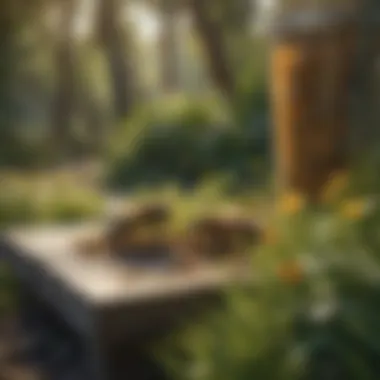
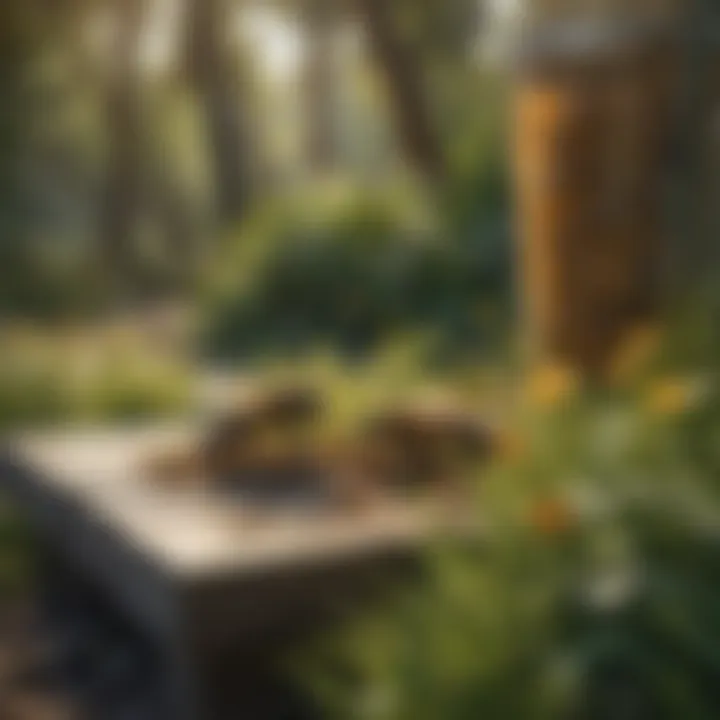
Managing Outdoor Waste
Proper waste management plays a significant role in discouraging bees and wasps. When food waste is not disposed of correctly, it becomes a beacon for these insects. It is essential to cover garbage bins tightly and take out trash regularly to limit odor that can attract unwanted visitors.
Consider these tips:
- Ensure lids of outdoor trash cans are secure.
- Clean waste containers frequently to remove any residue.
- Store compost bins away from living spaces.
- Avoid leaving pet food outdoors for extended periods.
These strategies create less appealing conditions for bees and wasps, ultimately lowering the likelihood of their visits.
Utilizing Decoys and Traps
To further complement the waste management techniques, using decoys and traps effectively deters wasps and bees. This section can guide on how these methods function and their advantages.
Decoy Nests
Decoy nests mimic active wasp homes. When real wasps discover these artificial nests, they often perceive the area as occupied and will be less likely to settle in. This makes decoy nests an advantageous method for homeowners who prefer natural deterrents. Their effectiveness stems from the natural instinct of wasps to avoid competition.
Some essential points about decoy nests include:
- Useful in reducing wasp populations.
- Can be made from inexpensive materials like paper or plastic.
- Should be placed in areas where wasps are typically seen.
A key characteristic of decoy nests is that they require minimal maintenance once set up. They provide a non-invasive method to keep your space free of these insects.
Homemade Traps
Homemade traps serve as a practical and effective method for controlling bee and wasp populations. These traps can be made with simple materials found around the house. Commonly, plastic bottles can be altered to create a functional trap.
The main appeal of homemade traps is affordability and ease of creation. Such traps can be baited with sugary substances or proteins, depending on the insects targeted.
Consider the advantages of homemade traps:
- Cost-effective compared to commercial options.
- Customizable based on available materials.
- Can be placed strategically to attract and catch insects before they become a nuisance.
It is also important to note that homemade traps might require periodic checks to maintain their effectiveness. Regular monitoring helps in emptying and refilling traps, ensuring they serve their purpose well.
"By managing waste, utilizing decoys, and employing homemade traps, homeowners can significantly reduce the presence of bees and wasps, creating a safer environment for their families."
By effectively combining these strategies, you can create an environment where bees and wasps feel unwelcome. The result is a more enjoyable outdoor space, free from the disturbance of these insects.
Timing and Strategy
Understanding the timing and strategy for managing bees and wasps is crucial for achieving effective control over these insects. These pests do not just appear at random; their activity is influenced by various environmental conditions. By recognizing their behavior patterns, homeowners can better coordinate their outdoor activities. Proper timing can significantly reduce encounters with these insects, promoting a safer and more pleasant outdoor environment.
Optimal Times for Outdoor Activities
Knowing when bees and wasps are most active can greatly inform any outdoor plans. Generally, these insects tend to be more active during the warmer parts of the day, particularly in mid to late afternoon. To minimize interactions with them, scheduling activities in the early morning or late evening can be beneficial. During these times, bees and wasps are less likely to be troubling anyone.
Additionally, avoiding flowering plants during peak bloom hours is wise, as this is when these insects are usually foraging. It is also noteworthy that wasps are more aggressive in late summer and early fall, as they search for food sources to sustain their colonies. Understanding these patterns allows for more strategic planning around outdoor gatherings or gardening.
"Timing is everything. By choosing periods when bees and wasps are less active, one can significantly lessen the likelihood of unwanted encounters."
Seasonal Changes in Insect Behavior
Bees and wasps exhibit distinct behavioral patterns across different seasons. Understanding these changes is essential for long-term pest management. In early spring, their numbers are lower and their activity is primarily focused on establishing nests and foraging for food. During this period, the urgency to deter them can be less, as they will not be as prevalent.
However, as the seasons progress into the summer, populations surge. This is when they become more noticeable and aggressive, typically scavenging for food during outdoor picnics or gatherings. Awareness of this seasonal spike is essential when planning outdoor events, especially in yards or gardens.
In the fall, their behavior shifts again. As temperatures cool, these insects become more desperate for sustenance, leading to increased interactions with humans. This is the time to be especially vigilant about managing waste and keeping food covered.
By being mindful of the seasonal fluctuations in bee and wasp behavior, homeowners can implement specific strategies tailored to each season, ensuring a controlled and more pleasant environment year-round.
Long-Term Prevention Techniques
Long-term prevention techniques are essential for effective management of bee and wasp populations around homes and gardens. These strategies not only mitigate immediate concerns regarding these insects but also foster a sustainable environment. Implementing these techniques means homeowners can proactively address the conditions that attract bees and wasps while benefiting from a more harmonious outdoor space. The focus on long-term solutions helps to preserve ecological balance without resorting to harmful chemicals.
Plant Choices for Bee and Wasp Management
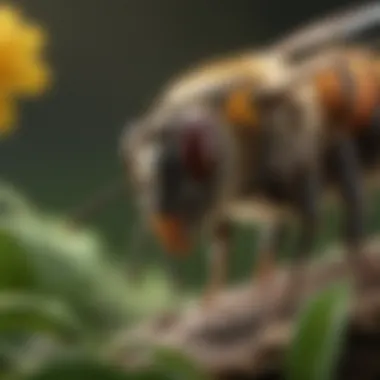
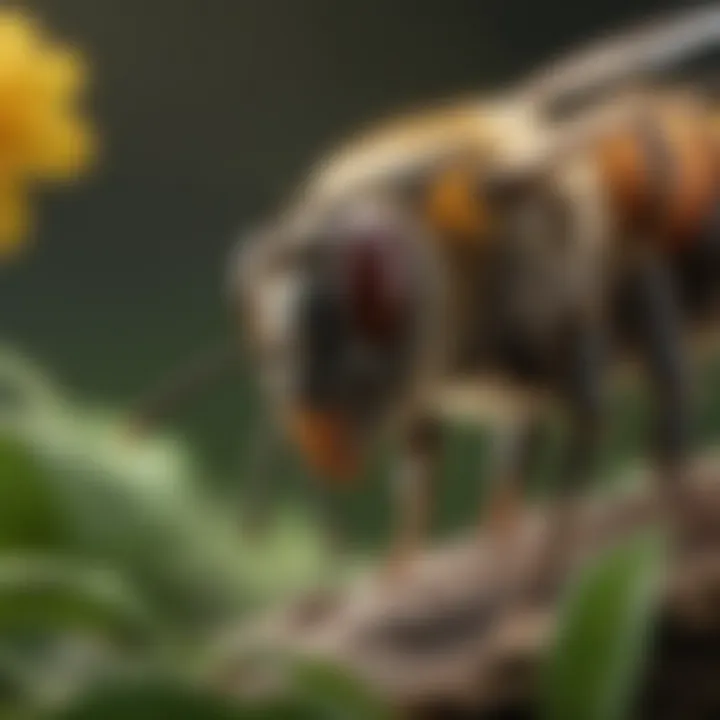
Selecting the right plants is a fundamental aspect of long-term prevention. Some plants are particularly attractive to bees and wasps, drawing them close to your living spaces. To address this, consider integrating plants known to deter these insects. Here are a few that are recommended:
- Lavender: Its scent is pleasant to humans but unappealing to many insects.
- Marigolds: The strong aroma of marigolds can mask the scents that attract bees and wasps.
- Mint: This herb produces a fragrance that repels many pests, including wasps.
When planning your garden, create a landscape that prioritizes these plants while minimizing those that draw in more bees and wasps. This simple adjustment can significantly reduce their population in your area.
Using Physical Barriers
Physical barriers are another effective method for long-term prevention. These barriers can be implemented to restrict access to areas where bees and wasps might establish nests. Common options include:
- Screens: Installing fine mesh screens on windows and doors will prevent easy access to inside spaces.
- Netting: Use netting around gardens or specific plants to keep out these insects while allowing air and sunlight in.
- Fencing: Building fences around outdoor dining areas can provide a degree of separation that helps reduce unwanted insect visitors.
These physical strategies serve dual purposes. They not only help deter pests but also create specific zones for outdoor activities. By maintaining such barriers, homeowners can enjoy their gardens and patios with a decreased likelihood of encounters with bees and wasps.
Effective long-term prevention requires a combination of thoughtful plant choices and strategic physical barriers. These methods together create an inviting yet safe space to enjoy your outdoor environment.
Employing these long-term strategies requires initial planning and effort, but the sustained benefits, including a more pleasant outdoor experience, make them worthwhile.
Dealing with Established Nests
Dealing with established nests of bees and wasps is crucial for anyone looking to enjoy their outdoor space without unwanted disturbances. Understanding nest locations and characteristics will help in low-impact removal strategies. These insects play important roles in ecosystems, but their presence can become problematic, especially during peak activity seasons. By effectively managing nests, homeowners can reduce safety risks while maintaining ecological balance.
Safe Nest Removal Techniques
When it comes to removing nests, doing so safely is of top priority. Without delving into aggressive tactics, there are several natural methods homeowners can try.
- Timing Matters: The best time to attempt removal is during early morning or late evening when bees and wasps are less active. This reduces the risk of confrontation.
- Wear Protective Clothing: Before approaching the nest, put on long sleeves, gloves, and a hat. It is always wise to take precautions.
- Use Water: A bucket of soapy water can be effective. Soak the nest and the surrounding area. The soap clogs their breathing pores, leading to lower chances of survival without creating a hazardous situation.
- Natural Sprays: Vinegar solutions can deter many wasps. Combine equal parts of water and vinegar in a spray bottle and douse the nest. It must be done after sunset for best results.
- CAUTION with Heavy Nests: If the nest is large or near structures, consider leaving it alone. Fighting an infestation can escalate danger.
When to Seek Professional Help
Despite best efforts, some situations demand expertise. Knowing when to call in professionals is vital.
- Size and Location: If the nest is large or hard to reach, like high up in a tree or behind walls.
- Special Needs: Anyone with allergies to stings or medical issues requiring immediate attention should seek aid.
- Persistent Problems: Repeated infestations in the same area signal a larger problem that needs more than DIY removal.
"The risks involved in dealing with established nests often outweigh the benefits of DIY removal attempts. Prioritize safety."
- Local Services: Many local exterminators specialize in eco-friendly removal options. They have the knowledge to handle these delicate situations while promoting balance in nature.
Education and Awareness
Education and awareness are key components in effectively managing bees and wasps in our environments. Not only does understanding the behaviors and characteristics of these insects aid homeowners and gardeners, but it also promotes safe interaction with them. As urbanization increases, encounters with bees and wasps become more common. Therefore, it is necessary to recognize their roles and the basic principles that govern their actions.
One important aspect of education is recognizing that bees and wasps are not inherently harmful. Many species are crucial for pollination, which is vital for the ecosystem and agriculture. Misunderstandings regarding their nature may lead individuals to seek harmful solutions that could disrupt local ecosystems. By fostering awareness about these insects, we can develop a more respectful and informed approach toward their management.
Benefits of Education
- Informed Decision Making: Knowing how to identify various species helps in distinguishing between beneficial pollinators and potential pests. This aids in choosing appropriate management strategies that do not harm the ecological balance.
- Increased Safety: Knowledge about insect behavior allows individuals to act calmly if a bee or wasp is nearby, thus reducing panic and increasing safety. For example, recognizing nesting behavior can prompt a proactive approach to prevention.
- Enhanced Coexistence: Education cultivates an understanding of the benefits bees and wasps bring, promoting harmony between humans and these vital pollinators.
Awareness also fosters empathy towards bees and wasps. By educating ourselves about their role in pollination, we gain a deeper appreciation for their presence in gardens and nature. Recognizing that these insects generally do not sting unless provoked can change how we interact with them.
"By understanding the behaviors and roles of bees and wasps, we can manage our environments effectively and sustainably."
Understanding Insect Behavior
Understanding insect behavior is essential for effective management of bees and wasps. Each species has distinct characteristics and patterns of flight, foraging, and nesting that are crucial to comprehend. Recognizing these behaviors can help individuals predict interactions and take appropriate action.
For instance, bees generally are attracted to flowers due to their need for pollen. On the other hand, wasps may be drawn to sugary substances and proteins, particularly in late summer when their natural food sources dwindle. By understanding what attracts these insects, one can minimize these attractants to reduce encounters.
Moreover, learning about their communication methods is also beneficial. Some wasps communicate alarm signals through pheromones. This means that an encounter with one individual can quickly escalate into a larger disturbance. Thus, knowing the signs of distress in insect behavior can guide preventive measures effectively.
Key Considerations
- Nest Size: Different species build nests that vary in size and location. Spotting a small yellowjackets nest can prevent larger problems in the future when colonies grow.
- Foraging Patterns: Observing when bees or wasps are most active can help in planning outdoor activities. Typically, they are more active during warm days in the afternoon.
Thorough knowledge of insect behavior is a powerful tool for managing unwanted encounters, allowing individuals to employ timely and effective strategies.
Promoting Coexistence with Pollinators
Promoting coexistence with bees and wasps can lead to a richer ecosystem while maintaining a safe environment for human activities. Developing an understanding of their importance is the first step towards fostering a symbiotic relationship.
Strategies to Promote Coexistence
- Plant Diversity: Planting a variety of flowering plants provides bees with essential forage while potentially distracting them from human gatherings. Choosing native plants can be particularly effective, as they attract beneficial local species.
- Provide Water Sources: A shallow water source can serve as a safe spot for bees and wasps to drink without posing a threat to humans. This encourages their presence while keeping their needs met.
- Reduce Chemical Use: Minimizing or eliminating pesticide use helps in protecting these pollinators' populations and their habitats. Natural repellents or Integrated Pest Management strategies can serve as better alternatives.
These practices not only help in deterring certain insects but also support the vital role bees and wasps play in pollination and ecological balance. When embraced, coexistence strategies can cultivate appreciation for these creatures and enhance the overall health of the outdoor environment.